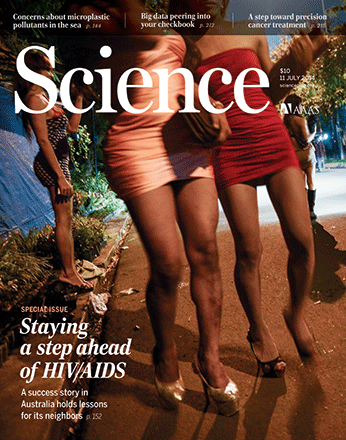Note: this is an updated version of my recent article at Autostraddle.
Update 2: I noticed that Science Careers editor Jim Austin has quietly deleted the most egregious of his tweets. I take that much as a small, positive development.
One of the best known and most respected publications in science and technology chose to run a sexualized, trans-misogynistic photo for its cover this week, and when the editor was challenged on twitter for pandering to the male gaze, he responded that he thought it would be interesting what would happen when those males “find out” the women in question are transgender.
While the focus of Science magazine’s July 11 issue on combating HIV and AIDS worldwide is laudable, the editors unfortunately chose the route of crude sensationalism to present that story to the public. The magazine cover features a dehumanizing image of trans women sex workers in Jakarta that focuses on their bodies, crops out their faces and primarily centers on their exposed thighs. The text accompanying that picture says, “Staying a step ahead of HIV/AIDS,” as if trans sex workers are somehow an image that is naturally synonymous with this disease.
And while, yes, trans women globally, on average, do face significantly elevated risks, could you imagine how out of place it would be for Science to run the same cover text accompanied by an image of two men in a sexual embrace, and further only showed them from the neck down? It has also been pointed out that apparently Science has never previously run any similar cover image that crops human bodies in a sexualizing manner.
However, when one of the Science editors was challenged on twitter over this image, the situation worsened quickly. When several people challenged Jim Austin, Science Careers Editor, about the blatant sexism on the cover, Austin responded by saying, “You realize they are transgender? Does it matter? That at least colors things, no?” as if crudely sexualizing women suddenly becomes okay as long as they’re trans.
!!! RT @LSU_FISH When we said we wanted more women in Science this is not what we meant. @AAASmember pic.twitter.com/oi4rrt5cuv
— Jacquelyn Gill (@JacquelynGill) July 16, 2014
@JacquelynGill @LSU_FISH @AAASmember You realize they are transgender? Does it matter? That at least colors things, no? — Jim Austin (@SciCareerEditor) July 16, 2014
@JacquelynGill then challenged the idea that sexually dehumanizing trans women is okay by saying the image was just another “male gazey image,” Austin responded, ” Interesting to consider how those gazey males will feel when they find out.”
@SciCareerEditor It’s not clear from the cover image. I don’t think it’s ok to sexually objectify transwomen, either. @LSU_FISH @AAASmember
— Jacquelyn Gill (@JacquelynGill) July 16, 2014
@JacquelynGill @LSU_FISH @AAASmember To me it defies the obvious stereotypes, problemetizes responses in interesting ways.
— Jim Austin (@SciCareerEditor) July 16, 2014
@SciCareerEditor I’m not sure how you get that, at all. To me it’s just another dehumanizing male gazey image. @LSU_FISH @AAASmember
— Jacquelyn Gill (@JacquelynGill) July 16, 2014
@JacquelynGill @LSU_FISH @AAASmember Interesting to consider how those gazey males will feel when they find out.
— Jim Austin (@SciCareerEditor) July 16, 2014
Here Austin has gone far beyond the line and is starting to play into violently anti-trans woman ‘deception’ tropes. The fact is that this type of rhetoric has been used for years to promote victim-blaming myths against trans women, and has even been used in court cases to reduce sentences or free cis men from culpability for murdering trans women (even in cases where the men in question actually knew the woman was trans all along). These statements, particularly when taken in conjunction with an image catering to the male gaze, also buy into the idea that trans women’s bodies are somehow public domain. And above all, they buy into the utterly stupid, unscientific idea that cis males somehow have some kind of “right” to not be attracted to trans women.
If a man is uncomfortable with his own sexual attractions, that is not a public issue, that is his own problem that he needs to sort out for himself. And the recent spate of often brutal murders against trans women of color across the U.S. emphasize that the priority in this conversation must be the safety of women, not the hand-wringing of men who lack the personal integrity to make sense of their own sexual desires in a healthy, reasonable way.
And to describe it as disappointing for a respected scientific publication to run this sensationalizing, click-bait cover would be a major understatement. Indeed the text that accompanies the cover on their website reads
COVER Transgender sex workers in Jakarta. This “key affected population” has high HIV prevalence but is largely ignored by government efforts.
Yet, when you click on the linked cover story, it doesn’t actually mention trans people at all.
To it’s credit, Science has now published an apology along with the cover on their website. But the apology doesn’t actually speak to the crude sexualization that made the cover such a poor choice in the first place, nor does it speak to one of its editor’s utterly over-the-top comments in defense of it (and notice that that editor’s comments did acknowledge the sexualizing element as intentional).
As a professional scientist and a transgender woman, I expect better from those who speak in respected positions for the scientific community.


Leave a comment
Comments feed for this article